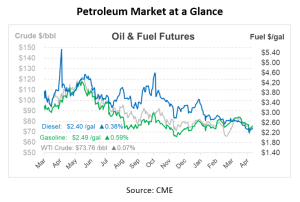
What is it – Octane Rating
Do you pay attention to the yellow labels at retail gasoline pumps? Did you know that those yellow labels represent the different grades of gasoline and their corresponding octane ratings? Understanding octane ratings can help you make informed decisions when refueling your vehicle or truck to ensure optimal engine performance and fuel efficiency. Now that you are curious, let’s talk about what these yellow labels actually mean for you and your vehicle.
What is an octane rating?
An octane rating, also known as the octane number, is a standard measure of the performance of an engine or aviation gasoline. It indicates the fuel’s stability or resistance to knocking or pinging during combustion, which occurs when fuel in the cylinders is ignited too early, causing a knocking noise and potentially damaging the engine. The higher the octane number, the greater the fuel’s resistance to knocking or pinging, which allows for smoother and more efficient engine performance.
The petroleum industry uses two primary methods to determine the octane rating of gasoline: the Research Octane Number (RON) and the Motor Octane Number (MON). In the United States, the Anti-Knock Index (AKI), which is the average of RON and MON, is used and displayed on gas pumps as (R+M)/2.

Is a higher or lower octane rating better for my vehicle?
Octane ratings serve as indicators of fuel stability, with higher octane numbers being safer for vehicles. Using fuel with a lower octane rating than recommended may result in engine knocking, reduced performance, and potential long-term damage. On the other hand, using a higher-octane fuel than required typically offers no additional benefits and may be an unnecessary expense.
Standard engines in regular vehicles generally require lower octane fuel, while high-performance vehicles or engines with high compression ratios often need premium (higher octane) fuel to prevent knocking and ensure optimal performance. The effect of higher-octane fuel on engine performance depends on the engine’s design. High-compression gasoline engines can produce more power with higher octane fuels due to the increased compression by the engine. However, this increased power mainly results from the engine design, not the gasoline itself.
In contrast, fuels with lower octane ratings (and higher cetane numbers) are more suitable for diesel engines. Diesel engines, or compression-ignition engines, compress only air instead of the fuel directly and then inject the fuel into the heated compressed air. Gasoline engines depend on the ignition of an air-fuel mixture, compressed together and ignited towards the end of the compression stroke by electric spark plugs. Consequently, fuel compressibility is mainly crucial for gasoline engines. Utilizing gasoline with a lower octane rating can cause engine knocking (pre-ignition).
In the United States, retail gas stations typically offer three primary gasoline grades based on their octane levels:
- Regular (lowest octane fuel – usually 87)
- Midgrade (mid-range octane fuel – usually 89-90)
- Premium (highest octane fuel – usually 91-94)
Different companies might use alternative names for these gasoline grades, such as unleaded, super, or super-premium, but they all correspond to the fuel’s octane rating.
So, next time you’re at the pump, pay attention to the yellow labels and make an informed decision on which fuel grade to choose for your vehicle.

This article is part of Daily Market News & Insights
Tagged:
MARKET CONDITION REPORT - DISCLAIMER
The information contained herein is derived from sources believed to be reliable; however, this information is not guaranteed as to its accuracy or completeness. Furthermore, no responsibility is assumed for use of this material and no express or implied warranties or guarantees are made. This material and any view or comment expressed herein are provided for informational purposes only and should not be construed in any way as an inducement or recommendation to buy or sell products, commodity futures or options contracts.





